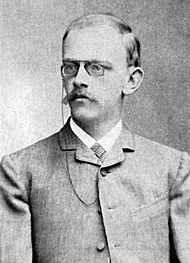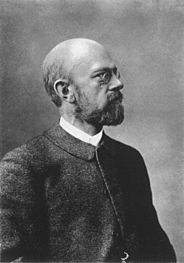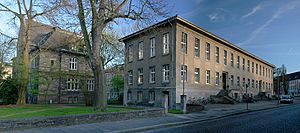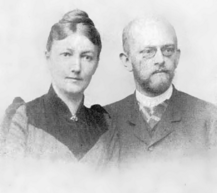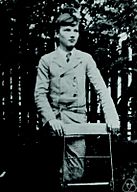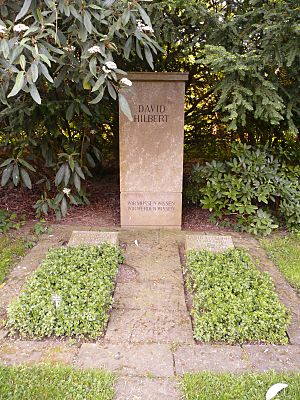David Hilbert facts for kids
Quick facts for kids
David Hilbert
|
|
|---|---|
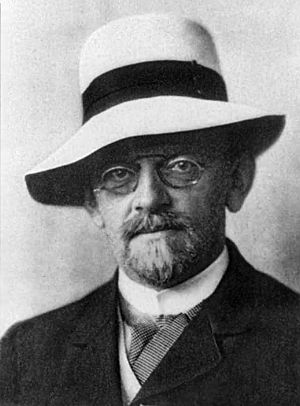
Hilbert in 1912
|
|
| Born | 23 January 1862 Königsberg or Wehlau, Prussia
|
| Died | 14 February 1943 (aged 81) |
| Nationality | German |
| Education | University of Königsberg (PhD) |
| Known for | Hilbert's basis theorem Hilbert's axioms Hilbert's problems Hilbert's program Einstein–Hilbert action Hilbert space Epsilon calculus |
| Spouse(s) | Käthe Jerosch |
| Children | Franz (b. 1893) |
| Awards | Lobachevsky Prize (1903) Bolyai Prize (1910) ForMemRS |
| Scientific career | |
| Fields | Mathematics, Physics and Philosophy |
| Institutions | University of Königsberg Göttingen University |
| Thesis | On Invariant Properties of Special Binary Forms, Especially of Spherical Functions (1885) |
| Doctoral advisor | Ferdinand von Lindemann |
| Doctoral students |
Wilhelm Ackermann
Heinrich Behmann Felix Bernstein Otto Blumenthal Anne Bosworth Werner Boy Ugo Broggi Richard Courant Haskell Curry Max Dehn Ludwig Föppl Rudolf Fueter Paul Funk Kurt Grelling Alfréd Haar Erich Hecke Earle Hedrick Ernst Hellinger Wallie Hurwitz Margarete Kahn Oliver Kellogg Hellmuth Kneser Robert König Emanuel Lasker Klara Löbenstein Charles Max Mason Alexander Myller Erhard Schmidt Kurt Schütte Andreas Speiser Hugo Steinhaus Gabriel Sudan Teiji Takagi Hermann Weyl Ernst Zermelo |
| Other notable students | Edward Kasner John von Neumann |
| Influences | Immanuel Kant |
David Hilbert (born January 23, 1862 – died February 14, 1943) was a very important German mathematician. He is considered one of the most influential mathematicians from the late 1800s and early 1900s. Hilbert discovered and developed many key ideas in different areas of mathematics. These included invariant theory, calculus of variations, algebra, number theory, the foundations of geometry, and mathematical physics.
Hilbert strongly supported Georg Cantor's ideas about set theory and very large numbers called transfinite numbers. In 1900, he shared a famous list of problems that guided a lot of mathematical research for the next 100 years. Hilbert and his students helped make mathematics more precise and created important tools used in modern physics. He is also known as one of the people who started proof theory and mathematical logic.
Contents
Life of David Hilbert
Early Life and Education
David Hilbert was born in Prussia, which is now part of Germany. He was the first child of Otto and Maria Therese Hilbert. He was born either in Königsberg or in Wehlau, a town nearby.
In 1872, Hilbert started at a school called Friedrichskolleg Gymnasium. This was the same school that the famous philosopher Immanuel Kant had attended many years before. After a difficult time there, Hilbert moved to the Wilhelm Gymnasium in 1879, which focused more on science. He graduated from there in 1880.
In the autumn of 1880, Hilbert began studying at the University of Königsberg. In 1882, another talented mathematician, Hermann Minkowski, joined the university. Hilbert and Minkowski became lifelong friends.
Starting His Career
In 1884, Adolf Hurwitz came to Königsberg as a professor. Hilbert, Minkowski, and Hurwitz began to share many scientific ideas. Hilbert earned his PhD in 1885. His main professor was Ferdinand von Lindemann. His PhD paper was about "invariant properties of special binary forms."
Hilbert stayed at the University of Königsberg as a lecturer from 1886 to 1895. In 1895, with help from Felix Klein, he became a Professor of Mathematics at the University of Göttingen. During the time that Klein and Hilbert were there, Göttingen became the most important place for mathematics in the world. Hilbert stayed at Göttingen for the rest of his life.
The Göttingen School of Mathematics
Many of Hilbert's students at Göttingen became famous mathematicians themselves. Some of them include Hermann Weyl, chess champion Emanuel Lasker, and Ernst Zermelo. John von Neumann also worked as his assistant. At Göttingen, Hilbert was surrounded by many other important mathematicians, like Emmy Noether.
Between 1902 and 1939, Hilbert was the editor of Mathematische Annalen. This was the leading mathematical journal of its time.
Personal Life

In 1892, Hilbert married Käthe Jerosch. She was a strong-minded young woman. They had one child, a son named Franz (born 1893). Franz suffered from a lifelong illness. This was a source of sadness for Hilbert and those around him.
Hilbert considered his friend Hermann Minkowski to be his "best and truest friend." Hilbert was raised in the Calvinist church but later became an agnostic. He believed that mathematical truths were true no matter what anyone believed about God.
Later Years and Challenges
Around 1925, Hilbert became very ill with a condition that made him extremely tired. Even after treatment, he was not as active in science as before.
In 1933, Hilbert saw the Nazi government force many talented professors to leave the University of Göttingen. These included Hermann Weyl, Emmy Noether, and Edmund Landau. One of his collaborators, Paul Bernays, also had to leave Germany.
About a year later, Hilbert was at a dinner with the new Minister of Education, Bernhard Rust. Rust asked if the Mathematical Institute had suffered much because Jewish professors had left. Hilbert famously replied, "Suffered? It doesn't exist any longer, does it?" This showed how much the university had been harmed.
Death and Legacy
David Hilbert died in 1943. By this time, the Nazis had replaced most of the university staff. Only a few people attended his funeral. News of his death did not reach the wider world for several months.
The words on his tombstone in Göttingen are very famous. They come from a speech he gave in 1930:
|
Wir müssen wissen. |
We must know. |
These words were a response to the idea that there are some things we can never know. The day before Hilbert said these words, Kurt Gödel announced his incompleteness theorem. This theorem showed that some logical statements cannot be proven or disproven within a given mathematical system.
Hilbert's Contributions to Mathematics and Physics
Solving Gordan's Problem
One of Hilbert's early achievements was his "finiteness theorem" in 1888. Before him, mathematician Paul Gordan had shown a similar theorem using very complicated calculations. When others tried to use Gordan's method for more complex problems, it became too difficult.
Hilbert realized he needed a completely new way to solve what was called "Gordan's Problem." He proved Hilbert's basis theorem. This theorem showed that a finite set of "generators" exists for certain mathematical forms. However, his proof did not show how to find these generators. It only proved that they exist.
When Hilbert sent his work to a math journal, Gordan himself rejected it. He said, "This is not Mathematics. This is Theology." But Felix Klein understood how important Hilbert's work was and made sure it was published. Hilbert's new way of proving things was very revolutionary.
Foundations of Geometry
In 1899, Hilbert published a book called Grundlagen der Geometrie (which means Foundations of Geometry). In this book, he presented a new, formal set of Hilbert's axioms. These axioms replaced the older ones from Euclid, which had some weaknesses. Hilbert's approach changed how mathematicians thought about axioms.
He showed that you don't need to imagine what a "point" or "line" is. You just need to define how they relate to each other. Hilbert famously said that you could replace points, lines, and planes with "tables, chairs, glasses of beer" and the geometry would still work, as long as their relationships followed the rules. His axioms brought together both flat (plane) geometry and 3D (solid) geometry into one system.
The 23 Problems
In 1900, at a big meeting of mathematicians in Paris, Hilbert presented a list of 23 unsolved problems. This list is considered one of the most important collections of open problems ever created by a mathematician. These problems set the direction for much of the mathematical research in the 20th century.
Some of these problems were solved quickly. Others were debated for many years. A few are still challenges today, or are seen as too open-ended to be fully "solved."
Formalism in Mathematics
Hilbert's list of problems also helped start the "formalist" school of mathematics. Formalists believe that mathematics is about manipulating symbols according to agreed-upon rules. This means that mathematics is a self-contained activity of thought.
Hilbert's Program
In 1920, Hilbert proposed a big research project called Hilbert's program. He wanted to build mathematics on a very strong and complete logical foundation. He believed that all of mathematics could come from a carefully chosen set of axioms. He also thought that this axiom system could be proven to be consistent (meaning it wouldn't lead to contradictions).
This idea is still important in the philosophy of mathematics today and is often called formalism.
Gödel's Impact
Hilbert and his colleagues worked hard on this program. However, their goal of proving that mathematics was completely consistent and complete faced a major challenge.
In 1931, Kurt Gödel showed that any formal system that is complex enough to include basic arithmetic cannot prove its own completeness using its own axioms. This meant that Hilbert's grand plan, as he stated it, was impossible. Gödel's work led to the development of mathematical logic as its own field. It also laid the groundwork for later theoretical computer science.
Contributions to Physics
Before 1912, Hilbert mostly focused on pure mathematics. His friend Hermann Minkowski joked that he needed to be in "quarantine" for 10 days before visiting Hilbert, because Hilbert was so focused on math and Minkowski was studying physics. Minkowski actually helped Hilbert get interested in physics before 1912.
In 1912, after Minkowski's death, Hilbert started focusing almost entirely on physics. He even got a "physics tutor" for himself. He studied topics like the theory of gases and radiation. Even during World War I, he continued to hold classes where he and his students studied the works of physicists like Albert Einstein.
By 1915, Hilbert became very interested in general relativity, Einstein's theory of gravity. He invited Einstein to Göttingen to give lectures on the topic. Around the same time, both Einstein and Hilbert were working on the main equations for general relativity. Einstein published his "Field Equations of Gravitation" in November 1915. Almost at the same time, Hilbert published his own work, "The Foundations of Physics," which also included a way to get these equations. Hilbert always gave Einstein full credit for creating the theory.
Hilbert's work also helped with the mathematical ideas behind quantum mechanics. His ideas were key to how Hermann Weyl and John von Neumann showed that two different quantum theories (Heisenberg's and Schrödinger's) were mathematically the same. The concept of a Hilbert space, named after him, is very important in quantum theory.
Hilbert also worked to make the mathematics used in physics more precise. He felt that physicists were sometimes "sloppy" with their math. He wanted to bring more rigor to the field. His colleague Richard Courant later wrote a famous book called Methods of Mathematical Physics, which included many of Hilbert's ideas. Hilbert famously said, "Physics is too hard for physicists," meaning that the necessary mathematics was often beyond them.
Number Theory
In 1897, Hilbert brought together the field of algebraic number theory in his important book Zahlbericht (meaning "report on numbers"). He also solved a major problem in number theory that had been posed by Waring in 1770. Like his finiteness theorem, his solution was an "existence proof," showing that solutions must exist without providing a direct way to find them.
He also made several important guesses about class field theory. These ideas were very influential. His name is still used in concepts like the Hilbert class field and the Hilbert symbol. Most of these ideas were proven true by 1930.
Works
Hilbert's collected works have been published several times. When they were first put together, many small errors in his original papers were corrected. These corrections did not change the main ideas of his theorems, except for one claimed proof about the continuum hypothesis.
See also
 In Spanish: David Hilbert para niños
In Spanish: David Hilbert para niños
Concepts Named After Hilbert
- List of things named after David Hilbert
- Foundations of geometry
- Hilbert C*-module
- Hilbert cube
- Hilbert curve
- Hilbert matrix
- Hilbert metric
- Hilbert–Mumford criterion
- Hilbert number
- Hilbert ring
- Hilbert–Poincaré series
- Hilbert series and Hilbert polynomial
- Hilbert space
- Hilbert spectrum
- Hilbert system
- Hilbert transform
- Hilbert's arithmetic of ends
- Hilbert's paradox of the Grand Hotel
- Hilbert–Schmidt operator
- Hilbert–Smith conjecture
Theorems by Hilbert
- Hilbert–Burch theorem
- Hilbert's irreducibility theorem
- Hilbert's Nullstellensatz
- Hilbert's theorem (differential geometry)
- Hilbert's Theorem 90
- Hilbert's syzygy theorem
- Hilbert–Speiser theorem
Other Related Topics
- Brouwer–Hilbert controversy
- Direct method in the calculus of variations
- Entscheidungsproblem
- Geometry and the Imagination
- General relativity priority dispute
Images for kids


